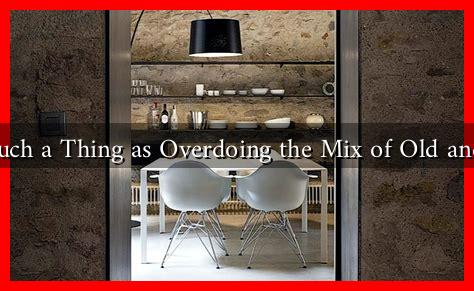-
Table of Contents
Is There Such a Thing as Overdoing the Mix of Old and Modern?
In the ever-evolving landscape of design, architecture, and lifestyle, the blending of old and modern elements has become a popular trend. This fusion can be seen in various domains, from interior design to fashion, and even in technology. However, the question arises: is there such a thing as overdoing this mix? In this article, we will explore the balance between old and modern, the potential pitfalls of excessive blending, and how to achieve a harmonious integration of styles.
The Allure of Mixing Old and Modern
The combination of vintage and contemporary styles can create a unique aesthetic that appeals to many. Here are some reasons why this trend has gained traction:
- Timelessness: Old elements often carry a sense of history and character that modern designs may lack.
- Contrast: The juxtaposition of old and new can create visual interest and depth in a space.
- Personalization: Mixing styles allows individuals to express their personality and taste, making spaces feel more personal.
For instance, a modern kitchen with vintage wooden cabinets can evoke warmth while maintaining a sleek, contemporary feel. Similarly, a classic armchair paired with a minimalist coffee table can create a striking focal point in a living room.
The Risks of Overdoing the Mix
While the blend of old and modern can be visually appealing, there are risks associated with overdoing it. Here are some potential pitfalls:
- Cluttered Aesthetics: An excessive mix can lead to a chaotic look, where the eye struggles to find a focal point.
- Incoherence: If not carefully curated, the combination of styles may feel disjointed and lack a cohesive narrative.
- Loss of Functionality: In some cases, prioritizing aesthetics over functionality can lead to impractical designs.
For example, a home that features a Victorian-era chandelier alongside ultra-modern furniture may create a confusing visual experience. The key is to find a balance that respects both styles without overwhelming the senses.
Finding the Right Balance
To successfully mix old and modern elements, consider the following strategies:
- Choose a Dominant Style: Decide whether you want the old or modern elements to take center stage and build around that.
- Limit the Palette: Stick to a cohesive color scheme to unify the different styles.
- Incorporate Textures: Use various textures to create depth and interest without overwhelming the space.
- Focus on Functionality: Ensure that the design remains practical and comfortable for everyday use.
For instance, a modern living room can be enhanced with vintage accessories like a retro rug or antique vases, creating a harmonious blend without overwhelming the space.
Case Studies: Successful Blends
Several designers and architects have successfully navigated the mix of old and modern. One notable example is the work of Kelly Wearstler, who is known for her ability to combine vintage pieces with contemporary design. Her projects often feature a mix of textures, colors, and styles that create a cohesive yet dynamic environment.
Another example is the Old Meets New project in London, where architects successfully integrated a modern extension with a historic building, preserving the character of the original structure while providing modern amenities.
Conclusion
In conclusion, while the mix of old and modern can create stunning and personalized spaces, it is essential to strike a balance to avoid overdoing it. By being mindful of aesthetics, functionality, and coherence, individuals can create environments that celebrate both history and contemporary design. The key takeaway is to embrace the beauty of both worlds while ensuring that they complement rather than compete with each other. Ultimately, the goal is to create spaces that are not only visually appealing but also functional and reflective of personal style.


